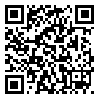Volume 7, Issue 13 (2020)
QHTS 2020, 7(13): 315-356 |
Back to browse issues page
Download citation:
BibTeX | RIS | EndNote | Medlars | ProCite | Reference Manager | RefWorks
Send citation to:



BibTeX | RIS | EndNote | Medlars | ProCite | Reference Manager | RefWorks
Send citation to:
Niazi S, Asghari J, Foadian M, hashemi E. A Study of the Efficiency of Valero-Garcés Model in the Assessment of the Qur'an Translation; A case study of Makarem’s Translation. QHTS 2020; 7 (13) :315-356
URL: http://qhts.modares.ac.ir/article-10-39599-en.html
URL: http://qhts.modares.ac.ir/article-10-39599-en.html
1- Tehran University
2- Tehran University , nc.hashemi65@gmail.com
2- Tehran University , nc.hashemi65@gmail.com
Abstract: (3223 Views)
The sensitivity of the text of the Qur'an requires careful evaluation of its translation. Such evaluation requires a scientific basis and a comprehensive model. In recent years, evaluators have used Translation evaluation models in evaluation of Quran translation, but those models are not designed to criticize the translation of a sacred text. Given the specific features of the Qur'an, its translation evaluation requires a distinctive and indigenous model. In order to design such a model, it is necessary to examine the models presented in translation studies. To this end, this paper studies the Garces’ model and its efficiency in evaluating the translation of the Qur'an. For this purpose, present paper evaluates the TT-oriented translation of Makarem and looks for efficient and inefficient components of the Garces’ model and its advantages and disadvantages. This study shows that the components of definition, expansion, Transposition, Modulation Explanation, creative expansion, inappropriate expression in TT, elaboration, and Variation in the use of rhetorical figures are the most efficient components in evaluating of Quran translation. On the other hand, Suppression of committed subject, Suppression of marginal text and Moderation in conversational expressions are inefficient and the other components have little efficiency. The advantages of the Garces’ model are its multilevel and minimized components, as well as its special attention to the rhetorical figures. The disadvantages of this model are the general division of the components into positive and negative, regardless of their necessity, some components interference, and the lack of components for discursive cohesion.
Keywords: Quran Translation, Translation Assessment Model, Model evaluation, Valero-Garcés, Makarem-Shirazi
Article Type: مقالات علمی پژوهشی |
Subject:
Arts and Humanities (General)
Received: 2020/01/3 | Accepted: 2020/03/13 | Published: 2020/09/12
Received: 2020/01/3 | Accepted: 2020/03/13 | Published: 2020/09/12
Send email to the article author
| Rights and permissions | |
 |
This work is licensed under a Creative Commons Attribution-NonCommercial 4.0 International License. |








